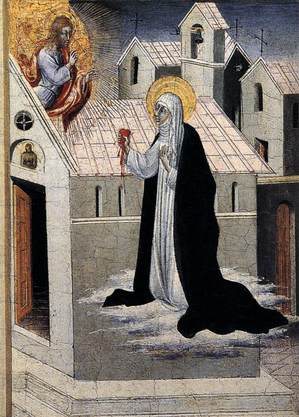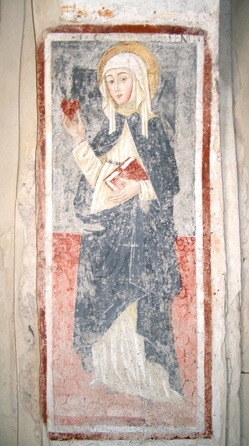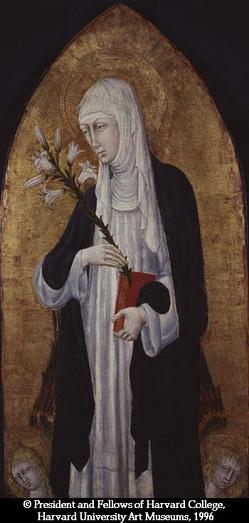 Today is the transferred feast of the great Dominican saint, Catherine of Siena.
Today is the transferred feast of the great Dominican saint, Catherine of Siena.
Tag: St Catherine of Siena
Pope shows us that “True authority is humble service in love”
The homilies and brief Angelus talks of the Pope really set the stage for what we ought to pay attention to in our spiritual life. His thinking is clear, and germane. Today is no different. How is it that we recognize and live within the authority of Jesus?
Jesus, on the Sabbath day, as he preached at the synagogue at Capernaum, the
small town where Peter and his brother Andrew lived on the lake of Galilee. In
his teaching, which arouses the wonder of the people, following the liberation
of “a man with an unclean spirit” (v. 23), who recognizes in Jesus as
the “saint of God,” that is, the Messiah. In a short time, his fame
spread throughout the region, which he travels announcing the Kingdom of God
and healing the sick of all kinds: word and deed. St. John Chrysostom observes
how the Lord “alternates the speech for the benefit of those who listen,
moving on from wonders to words and again passing from the teaching of his
doctrine to miracles” (Hom. on Matthew 25, 1: PG 57, 328).
Continue reading Pope shows us that “True authority is humble service in love”
Saint Catherine of Siena
 Today is a fitting day to pray for the Holy Father, Pope Benedict. Saint Catherine was a woman of great courage and vision who promoted unity with the Church. Her crusade was a crusade for souls, for the salvation of many to heart of Christ through the ministry of Christ’s vicar, the Pope. That today we are still in the Easter Octave, Siena’s feast is not being observed except in places of the Order of Preachers. We are doing so today the Church of Saint Catherine of Siena, NYC, with a Octave Mass of Easter with elements of Saint Catherine’s Mass parts intelligently placed; Holy Mass is being celebrated by the Most Rev’d Octavio Cisneros, an auxiliary bishop of Brooklyn.
Today is a fitting day to pray for the Holy Father, Pope Benedict. Saint Catherine was a woman of great courage and vision who promoted unity with the Church. Her crusade was a crusade for souls, for the salvation of many to heart of Christ through the ministry of Christ’s vicar, the Pope. That today we are still in the Easter Octave, Siena’s feast is not being observed except in places of the Order of Preachers. We are doing so today the Church of Saint Catherine of Siena, NYC, with a Octave Mass of Easter with elements of Saint Catherine’s Mass parts intelligently placed; Holy Mass is being celebrated by the Most Rev’d Octavio Cisneros, an auxiliary bishop of Brooklyn.Catherine of Siena: A Passionate Life –book presentation at St Catherine of Siena Church NYC
 On Thursday, December 9, 2010 at 7:00 PM
On Thursday, December 9, 2010 at 7:00 PM
in Saint Catherine of Siena Church, 411 East 68th Street, NYC, author Don
Brophy will present his award winning new book, Catherine of Siena: A
Passionate Life.
Month Award, the same is forthcoming from the Catholic Press Association. Other
Catherine of Siena Scholars hail Don Brophy’s work as a masterpiece that
reveals in a new way the wonder and passion of Catherine of Siena in
medieval Europe and today.
as meeting the author.
Saint Catherine of Siena: ambassador, woman of holiness & spiritual mother
Pope Benedict spoke in his General Audience today of the great 14th century Dominican sister, Saint Catherine of Siena, holy woman, ambassador, truth-speaker, Doctor of the Church and spiritual mother. His choice of saint could not have been better since the presence of many of the new cardinals were in attendance. Rome Reports provides a brief video clip on the papal address.
Today I would
like to speak to you about a woman who has had an eminent role in the history
of the Church. She is St. Catherine of Siena. The century in which she lived —
the 14th — was a troubled time for the life of the Church and for the
whole social fabric in Italy and Europe.
However, even in
the moments of greatest difficulty, the Lord does not cease to bless his
People, raising men and women saints who stir minds and hearts, bringing about
conversion and renewal. Catherine is one of these and still today she speaks to
us and pushes us to walk courageously toward sanctity to be disciples of
the Lord in an ever fuller sense.
Born in Siena in 1347 to a very numerous
family, she died in her native city in 1380. At 16, moved by a vision of St.
Dominic, she entered the Dominican Third Order, in the feminine branch called
the Mantellate. She stayed with her family and confirmed the vow of virginity
she made privately when she was still an adolescent; she dedicated herself to
prayer, penance, and works of charity, above all for the benefit of the sick.
When
her fame for sanctity spread, she became the protagonist in an intense activity
of spiritual counsel, dealing with all categories of persons: nobles and
politicians, artists and ordinary people, consecrated persons, ecclesiastics,
and including Pope Gregory XI, who at that time resided in Avignon and whom
Catherine exhorted energetically and effectively to return to Rome. She
traveled a lot to solicit the interior reform of the Church and to foster peace
between states. For this reason also the Venerable John Paul II declared her
co-patroness of Europe: so that the Old World would never forget its Christian
roots that are at the base of its journey and continue to draw from the Gospel
the fundamental values that ensure justice and concord.
Continue reading Saint Catherine of Siena: ambassador, woman of holiness & spiritual mother
Saint Catherine of Siena, virgin and Doctor of the Church
The love of God has been poured into our hearts, alleluia, by His spirit living in us, alleluia.
God of wisdom, You made Saint Catherine burn with divine love in contemplating the Lord’s passion and in serving Your Church. With the help of her prayers may Your people, united in the mystery of Christ, rejoice forever in the revelation of His glory.
Ordination season is upon us. That is, you’ll may be hearing of or attending episcopal, priestly and diaconal ordination ceremonies. If you get the opportunity please attend an ordination ceremony. In reading Saint Catherine of Siena’s Dialogues, I thought her dialogue “The Qualities of Good Ministers in the Church” (119) as an appropriate reflection for all engaged in seminary formation at one level or another and for those already in service to the Church. Saint Catherine said:
I told you
that [my ministers] have taken on the qualities of the sun. Indeed, they are
suns, for there is in them no darkness of sin or ignorance, because they follow
the teaching of my Truth. Nor are they lukewarm, because they are set ablaze in
the furnace of my charity. They have no use for the world’s honors and ranks
and pleasures. Therefore, they are not afraid to correct. Those who do not
hanker after power or ecclesiastical rank have no fear of losing it. They
reprove [sin] courageously, for those whose conscience does not accuse them of
sin have nothing to fear.
So this pearl [of justice] was not clouded over in
these anointed ones, these christs of mine, of whom I have told you. [St
Catherine here is referring to holy people of the past who showed themselves to
be good ministers, and whose qualities are always needed in the Churcch]. No,
it was luminous. They embraced voluntary poverty and sought after lowliness
with deep humility. This is why they are not annoyed by people’s derision or
abuse or slander, or by the insult or shame or pain or torture. They were
cursed, and they blessed. They endured with true patience, likely angels and
more than angels -not by nature, but because of the sacramental grace given
them from above to be the stewards of the body and blood to my only begotten
Son.
How humbly they governed and communicated with their subjects! With what
hope and lively faith! They had no fear or worry that either they or their
subjects would be lacking in temporal goods, so they generously gave out the
Church’s possessions to the poor. Thus they fulfilled to the utmost their
obligation to divide their temporal goods to meet their own needs and those of
the poor and the Church. they set nothing aside, and after their death there
was no great estate to settle; in fact, some of them left the Church in debt
for the sake of the poor–all because of their generous charity and their trust
in my providence. They were strangers to slavish fear, so they were confident
they would lack nothing, either spiritually or temporally.
Because I had
appointed them to such dignity for the salvation of souls, they never rested,
good shepherds that they were, from gathering the little sheep into the
sheepfold of holy Church. In their love and hunger for souls they even laid
down their lives to rescue them from the devils’ hands (cf. Jn 10). They made
themselves weak along with those who were weak. That is, to keep the weak from
being confounded with despair and to give them more room to expose their
weakness, they would slow their own weakness, saying, “I am weak along with
you.” They wept with those who wept and rejoiced with those who rejoiced (cf. 1
Cor. 9:22; Rom 12:15). Thus they knew how to give everyone the right food ever
so tenderly. They encouraged the good by rejoicing in their goodness, for they
were not gnawed up with envy but broad in generosity of their neighbors and
subjects. Those who were sinful they drew out of their sin by showing that they
themselves were also sinful and weak. Their compassion was true and holy, and
while correcting others and imposing penances for the sins they had committed,
they themselves in their charity did penance along with them. Because of their
love, they who were imposing the penance suffered more than those who received
it. And sometimes some of them actually did the same penance themselves,
especially when they saw that it seemed very difficult for the penitent. And by
that act the difficulty became sweet for them.
(Sr. Mary O’Driscoll, OP, Catherine of Siena: Passion for the Truth, Compassion for Humanity, Hyde Park: New City Press, 1993).
Spiritual Maternity in Saint Catherine of Siena
‘Finish Your Life on the Cross’: Spiritual Motherhood in Saint Catherine of Siena’s Letters to Priests” by Sister Gabriella Yi, O.P was published in L’Osservatore Romano (August 12th-19th English edition). The author, Sister Gabriella Yi, O.P., is a member of the Congregation of St. Cecilia in Nashville, TN (also known as the Nashville Dominicans). A few times in the past I have posted some items on spiritual maternity and its necessity in the Church today, especially in the life of the priest.
At the foot of the cross, in the heart of the redemption, Our Lord Jesus Christ instituted a “new motherhood of Mary,” as he entrusted his mother to his beloved disciple and his beloved disciple to his mother. From this entrustment flows Our Lady’s spiritual motherhood of each member of Christ’s body, the Church, and especially her motherhood of his priests. Her maternal care for each priest was brought to our attention in a particular way by the Congregation for the Clergy’s teaching that, in union with Mary, all women are invited to live out their vocation to spiritual motherhood by offering their prayers and sacrifices for the salvation of souls and the holiness of Christ’s priests.
In his 1988 apostolic letter, Mulieris Dignitatem, Pope John Paul II speaks of motherhood and virginity as two important and related dimensions of a woman’s vocation. He describes how the vocation to motherhood is inscribed in the very being of a woman: she is not only physically but also psychologically endowed with the capacity to create a space within herself for another human being. John Paul speaks of this as a special “entrustment” that God has made to woman; she has the beautiful privilege of bringing forth new life into the world by the generous use of her feminine gifts.
Even those called to a life of consecrated virginity are not excluded from this vocation to motherhood. For them, John Paul says, there is the possibility of “a different kind of motherhood: a motherhood ‘according to the Spirit’. “In the life of consecrated women, this motherhood “can express itself as concern for people, especially the most needy….” John Paul is careful to point out that this concern for others on the part of consecrated women is motivated by spousal love for Christ. Just as natural motherhood is the fruit of the spousal love in marriage between husband and wife, spiritual motherhood is the fruit of the spousal love in religious life between the consecrated virgin and Christ.
What may come as a surprise to some is John Paul’s insistence that spiritual motherhood is not limited to unmarried women: “And does not physical motherhood also have to be a spiritual motherhood, in order to respond to the whole truth about the human being who is a unity of body and spirit?” John Paul II evidently sees it as an important dimension of every woman’s vocation.
The doctor of the Church who most clearly articulates this vocation to spiritual motherhood is the 14th century Dominican tertiary Saint Catherine of Siena, who is perhaps best known for the prayers, sacrifices, and counsel she offered Pope Gregory XI in his decision to return the papacy from Avignon to Rome. In looking to her as a model of spiritual motherhood for priests, we discover that Catherine teaches not only by the example of her prayers and sacrifices, but also by the counsel she offers in her letters: “See that in everything you turn to Mary as you embrace the cross,” “Make your home in the pulpit of the cross,” and “Finish your life on the cross,” encouraging her spiritual sons to identify themselves ever more closely with Christ the High Priest. Catherine’s spiritual motherhood, as seen in these letters, offers us a rich source of inspiration as we enter into this “Year for Priests.”
Catherine’s letters to priests often include words of encouragement in times of difficulty, as she writes to Blessed Raymond of Capua, referring to herself in the third person: “I’ve heard from a servant of God who constantly holds you before God in prayer, that you have been experiencing tremendous struggles and that your spirit has been overtaken by darkness because of the devil’s illusions and deceits.” With this image of holding a soul before God in prayer, as a mother holding her child out so that its Father might take it up into his arms, Catherine reveals the maternal quality of her prayer. With a mother’s intuition illumined by the Holy Spirit, she perceives the spiritual darkness he has fallen into and explains the enemy’s tactics: “He wants to make you see the crooked as straight and the straight as crooked, and he does this to make you stumble along the way so you won’t reach your goal.” In the face of such diabolical attempts to impede his priestly ministry, Catherine assures Raymond, “But take heart. God has provided and will continue to provide for you, and his providence will not fail you.” A priest’s confidence is to be placed, not in himself, where it is sure to fail, but in God’s providential care for him, especially in the form of his mother. As Our Lady’s maternal love for her son embraced him from the moment of his Incarnation to his death on the cross, so, too, does her maternal love embrace his priests in her constant intercession for them. Thus, they can entrust their priestly hearts wholly to hers, especially in times of discouragement, as Catherine advises, “See that in everything you turn to Mary as you embrace the cross.”
But it is not enough to embrace the cross-it must be mounted, as Catherine explains in her letter to Frate Bartolomeo Dominici: “After the fire of the Holy Spirit had descended on [the disciples], they mounted the pulpit of the blazing cross, where they felt and tasted the hunger of God’s Son, his love for humankind.” With this striking image, Catherine expresses the complete identification of Christ and his priests on the cross, blazing with the fire of divine charity, where they feel what he felt and taste what he tasted in his all-consuming love for us. Only from such a pulpit of divine charity do the words of priests wield supernatural power: “Then their words came forth as does a red-hot knife from a furnace, and with its heat they pierced their listeners to the heart and cast out the devils.” Indeed, many of Catherine’s own listeners were pierced to the heart, not only by her words, but also by those of the priests to whom she sent them in the pulpit of the confessional. Whether he is casting out devils in the confessional or at the altar, the pulpit of the cross is where the priest of Christ belongs, as Catherine implores, “So, my dearest son, I beg you-it is my will in Christ Jesus-make your home in the pulpit of the cross.”
From this pulpit, a priest of Jesus Christ engages in a battle for souls, beginning with his own, which is why in her letter to Frate Ranieri Catherine urges, “I long to see you a real knight, fighting against every vice and temptation for Christ crucified with a true holy perseverance.” With such chivalric imagery, she appeals to his masculine instincts for battle and adventure, as she continues, “For it is perseverance that is crowned. You know that victory is achieved by fighting and perseverance. In this life we are set as on a battlefield and we must fight courageously, not dodging the blows or retreating, but keeping our eyes on our captain, Christ crucified, who always persevered.” Just as no soldier goes into battle at his own initiative, but solely at that of his captain, so too must a priest take his commands from Christ, who:
. . . didn’t give up when the Jews said, ‘Come down from the cross!’ Nor did the devil or our ingratitude make him give up fulfilling the Father’s command and our salvation. No, he persevered right up to the end, when he returned to the eternal Father with the victory he had achieved, the victory of having rescued humankind from darkness and given us the light of grace once again by conquering the devil and the world with all its pleasures. And it killed him: this Lamb took death for himself in order to give us life; by his dying he destroyed our death.
Finally, as no soldier dies for an abstraction he holds, but for a beauty he loves, so too must Christ’s priests live and die for love of the beauty of his bride, the Church. Hence, Catherine concludes her letter to this priest simply with, “Finish your life on the cross.”
In these letters to Blessed Raymond of Capua and other priests, the voice of Saint Catherine of Siena as a spiritual mother is unmistakable. The authority with which she speaks is that of one whose spousal love for Christ united her so closely to him that his desire for the salvation of souls and the holiness of his priests has become her very own. As Catherine joins “that gentle mother Mary” in interceding for Christ’s priests, she invites us to do the same. In light of the Congregation for the Clergy’s document calling for spiritual mothers for priests and Pope Benedict XVI’s dedication of the current year as a “Year for Priests,” a rediscovery of this spiritual mother’s letters to priests could not be more timely.
Saint Catherine of Siena
 The Kingdom of heaven is like a merchant seeking good pearls, who, when he had found one of great price, gave all that he had and bought it, alleluia.
The Kingdom of heaven is like a merchant seeking good pearls, who, when he had found one of great price, gave all that he had and bought it, alleluia.


